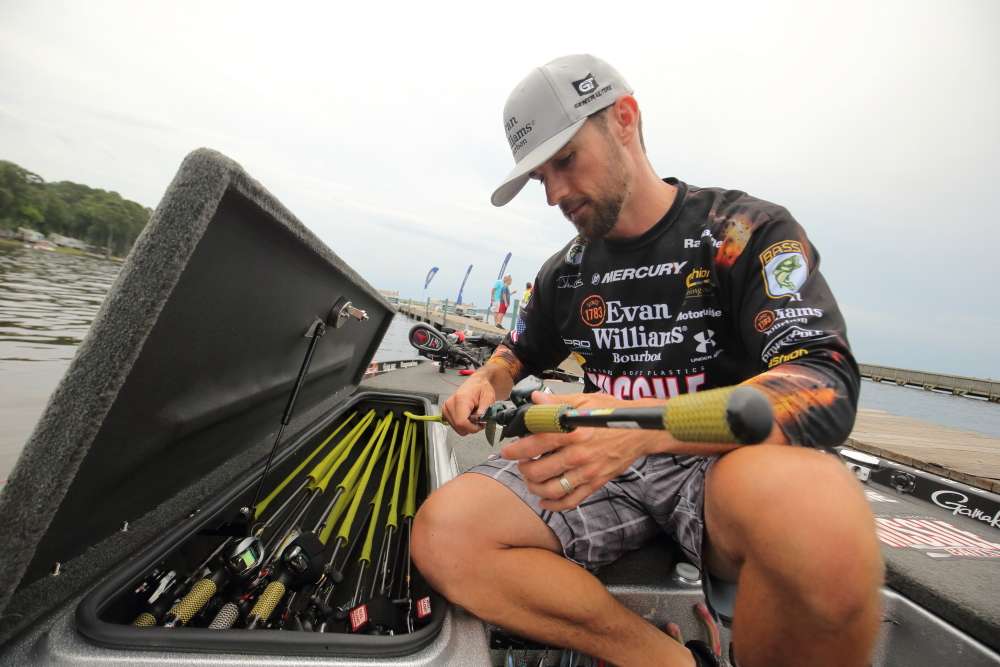
The average angler doesn’t need a dozen rods and reels. It’s nice to have that many, but for most anglers three will get you through almost any bass fishing scenario. And, you don’t need to buy the most expensive ones, either. Rods in the mid-price range will do you just fine.
Before we talk specifics, however, let’s talk about what makes a good rod.
The place to start is with the blank. High modulus graphite is my recommendation. It’ll give you a good combination of durability and feel. After that you want to look at the component parts — the tip, the guides, the wrapping, the reel seat and the handle. The safest bet here is to go with Fuji products. They’re durable and their quality control is excellent.
I’m partial to micro guides. They give you more feel and a little more casting distance because they funnel the casting energy in more of a straight line. The number of guides matters, too. More guides on the rod give the line more places to touch the rod. That makes for more feel.
From there you want to check out the workmanship on the rod. Are the wraps tight and clean, but not too tight? Is the glue and epoxy high-quality and flexible? Does the rod look clean and neat?
Some of this is tough to know by just looking. I know that. My recommendation is to ask around about the maker’s reputation. Make sure the people you talk to actually use the rods in real-world fishing situations. If you’re still in doubt, go with something that’s American made. There are rods made overseas that are good but day in and day out American quality is the best.
Price is a little more complicated. There’s a world of difference between a cheap rod and a medium priced rod. Almost anyone can tell that difference. There’s less difference between a medium priced rod and a high priced rod, and it takes a highly experienced angler to find that difference. Very few anglers need a super expensive rod. The medium price range is where most anglers will get their best value. Frankly, that’s what I use in the Bassmaster Elite Series.
Now, it’s time to talk specifics. I’m going to describe three rods that’ll get you through almost any bass fishing situation. Then I’ll give you my choice for that rod. From there you can make your own judgement.
Let’s start with a 7-foot, heavy action model with a little bit of tip. (A little bit of tip means a soft or fast tip.) I pair it with a high-speed reel. I probably catch more fish in a year with this rod than with any other I own.
It can be used for almost any technique involving worms or jigs. It’ll handle light pitching, too. I also use mine for plastic stickbaits, frogs and swim jigs.
My specific choice is a Cashion Rods model P8447.
My second casting rod is a 6-foot, 9-inch medium heavy model with a little more tip action. I also pair it with a high-speed reel. This is my most versatile rod. I’ve had one of these for years. It’ll handle jerkbaits, small spinnerbaits, small topwater plugs, small and medium size crankbaits, vibrating jigs and smaller swimbaits.
My specific choice is a Cashion Rods model M84369b.
The third rod that’ll complete our selection is a 7-foot, medium action spinning model with an 80/20 backbone to tip ratio. (That means it’ll bend near the tip like an L with 80 percent of the blank straight.) This is a very versatile size and action. It’s good with a shaky head, a drop shot, a wacky rig and almost any small jerkbait or crankbait.
Good spinning rods with the right action and that sell for a reasonable price are in limited supply. Look around carefully before you buy one.
My specific choice is a Cashion Rods model P8447s.
That’s it. If you have these three rods on the deck of your boat, or alongside your lawn chair, you should be in pretty good shape when it comes to fishing rods. You’ll be able to fish almost any bass lure out there.
Originally published in 2015.





